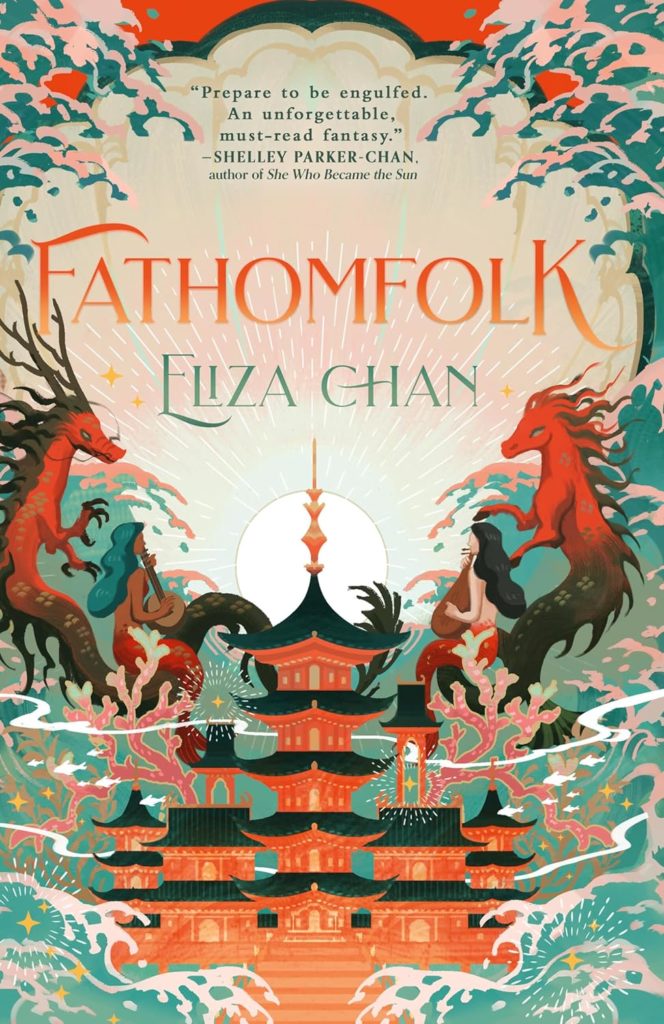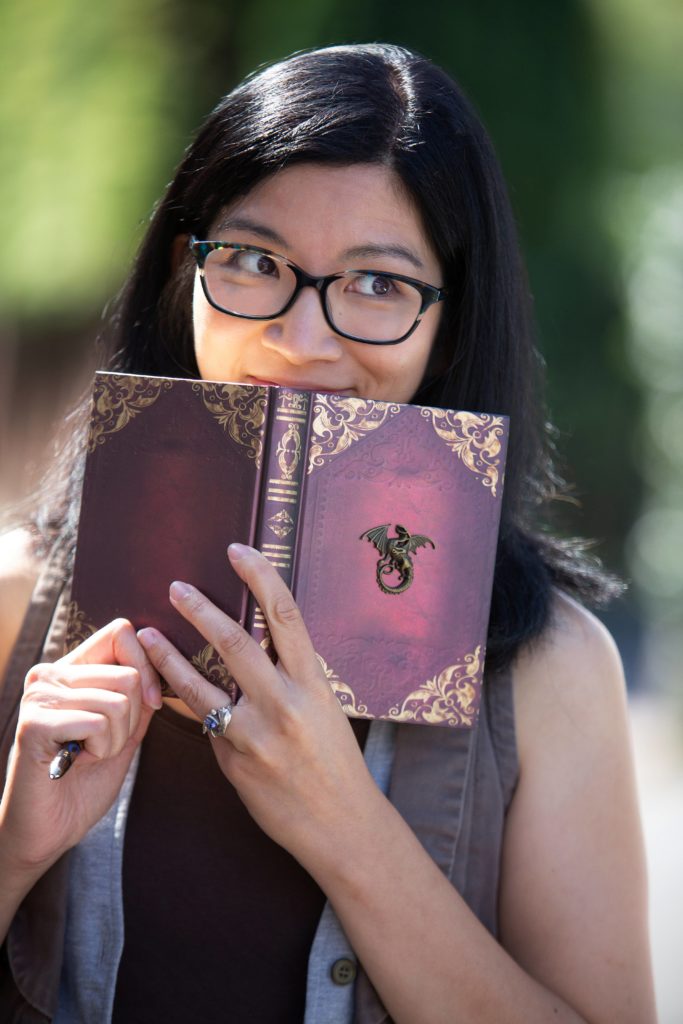Calling all foodies! Today I’m hosting an amazing guest post written by Eliza Chen, author of Fathomfolk all about the food in the book. It’ll make your mouth water!
About Fathomfolk

But in the semi-flooded city, humans are, quite literally, on peering down from skyscrapers and aerial walkways on the fathomfolk — sirens, seawitches, kelpies and kappas—who live in the polluted waters below.
For half-siren Mira, promotion to captain of the border guard means an opportunity to reform. At last, she has the ear of the city council and a chance to lift the repressive laws that restrict fathomfolk at every turn. But if earning the trust and respect of her human colleagues wasn’t hard enough, everything Mira has worked towards is put in jeopardy when a water dragon is exiled to the city.
New arrival Nami is an aristocratic water dragon with an opinion on everything. Frustrated by the lack of progress from Mira’s softly-softly approach in gaining equality, Nami throws her lot in with an anti-human extremist group, leaving Mira to find the headstrong youth before she makes everything worse.
And pulling strings behind everything is Cordelia, a second-generation sea-witch determined to do what she must to survive and see her family flourish, even if it means climbing over the bodies of her competitors. Her political game-playing and underground connections could disrupt everything Nami and Mira are fighting for.
When the extremists sabotage the annual boat race, violence erupts, as does the clampdown on fathomfolk rights. Even Nami realises her new friends are not what they seem. Both she and Mira must decide if the cost of change is worth it, or if Tiankawi should be left to drown.
(Disclaimer: Some of the links below are affiliate links. For more information you can look at the Policy page. If you’re uncomfortable with that, know you can look up the book on any of the sites below to avoid the link)
Find Fathomfolk on Goodreads, Storygraph, Amazon (US)(UK), Bookshop.org, & Blackwells.
“Have You Eaten Yet?”
“Have you eaten yet?” is a phrase familiar to many in BIPOC communities. Statements of love, pride or compliments might be as rare as pearls from older family members, but “Are you hungry?”, “You need to eat more” and “Don’t waste food” are much, much more common.
In my debut novel Fathomfolk, the East and Southeast Asian inspired semi-submerged cityscape is filled with a multicultural melting pot of different sea folk and humans, as well as their various foods. For me, one of the perks of living in a big melting pot city is experiencing different cuisines. I wanted this to be at the heart of many important scenes in my book also. In my research, I learnt about growing crops in salt water, vertical farming, hydroponics and sea vegetables. I gained a new respect for the lotus plant, not just a pretty water lily, it also has edible roots, stems, seeds and flowers and the leaves can be used to wrap food.
I love showing more about a character through their actions, especially that with food. Trish, Mira’s mother is never without a cup of seaweed tea, the drink of welcome and warmth. Putting the kettle on and offering a hot drink is drilled into my bones from British culture of a builder’s brew; to Chinese culture of being asked what tea you want before you’ve even removed your coat; to Japanese culture where a cup of green tea and a hot flannel on arrival at a restaurant is a given. And if there’s a nod to Uncle Iroh in there, then all the better.
Kai, the water dragon ambassador is a cinnamon roll who attends to everyone else first, leaving himself for last at every meal. He takes Mira and Nami to a fine dining establishment, because to him money is not object. He does not see what Mira sees that the refined elegance hides the fact that the food simply does not taste right, nor does it satisfy true hunger. Even Cordelia the seawitch, expresses her dissatisfaction through food when she is unable to directly take out her wrath on others.
Certain foods are associated with specific events and festivals in real life: stollen and panettone at Christmas, hot cross buns at Easter, mooncakes at Mid-Autumn Festival or tangyuan at Winter Solstice. In Fathomfolk, there are two big festivals mentioned. The first is Tidal Day, a fathomfolk festival about going upriver to pay respects to ancestors, influenced by Japanese Obon or Tomb Sweeping Day across many East and Southeast Asian cultures. For my version, this is a festival that has mostly been forgotten due to the rising water levels and the modernisations in city life. I epitomised this through traditional dancing but also dulse cakes shaped like shells in parcelled strings. Dulse is a type of edible red algae traditional eaten in places like Iceland or Ireland but my image of food hanging from strings is a nod to Asian zongzi also. For second generation half-siren Mira, she does not really understand the significance of the festival which she has never seen in its heyday in the submerged havens. For those in the diaspora, it can be a difficult line between wanting to embrace and celebrate the culture of your parents or grandparents when time and distance can mean it feels like you are a tourist.
I wanted to juxtapose this against the second significant festival: a modern, lively Boat Race Festival. I modelled this on contemporary festivals such as music, film or book festivals that are less restrained by tradition. Here the food is more eclectic, akin to a carnival or market stall. Candied lotus seeds and skewers of seafood fill the hawker stalls on the walkways and boats with all the hustle and bustle of something thriving and still evolving.
Food is a necessity of life but it can also have so many more meanings when used in fiction. A meal can signify unspoken love, hate, status, isolation. It was rewarding to use scenes of food to develop characters in Fathomfolk, but also I enjoyed it simply to make myself and hopefully the reader, hungry. I sampled seaweed salad, lotus root stew and sushi for “research” purposes. And if you finish reading the novel and feel the need to go out to eat, then one of my goals has been achieved.
Find Fathomfolk on Goodreads, Storygraph, Amazon (US)(UK), Bookshop.org, & Blackwells.
About the Author

Eliza Chan is a Scottish-born speculative fiction author who writes about East Asian mythology, British folklore and reclaiming the dragon lady. Her short fiction has been published in The Dark, Podcastle, Fantasy Magazine and The Best of British Fantasy. Her debut novel FATHOMFOLK — inspired by mythology, ESEAN cities and diaspora feels — was published by Orbit in Feb 2024.
She has been a medical school drop-out, a kilt shop assistant, an English teacher and a speech and language therapist, but currently she spends her time tabletop gaming, cosplaying, crafting and toddler wrangling.
Find out more on her website www.elizachan.co.uk.
One thought on ““Have You Eaten Yet?” Food in Fathomfolk by Eliza Chan”